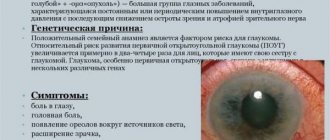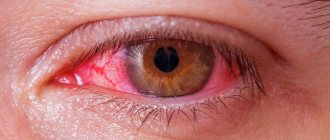What it is
Conjunctivitis is an inflammation of the conjunctiva or mucous membrane of the eye. The conjunctiva is a transparent film that covers the back of the eyelids and the front of the eye. It produces some important components of tear secretion and protects the eyes from germs and foreign particles.
In adults and children, conjunctivitis occurs in exactly the same way. As a rule, a problem arises when the body’s protective functions decrease. It is necessary to understand that it is very contagious, especially its viral and bacterial forms. Therefore, this pathology is quite quickly and easily transmitted from person to person, regardless of age and habits.
It should be understood that the infection may not appear immediately, but after a few days. The timing of manifestation, both in adults and in children, ranges from a couple of days to several days. Everything directly depends on the different types of disease.
How to treat?
General principles
- To eliminate pain, stinging and burning in the eyes, local anesthetics (Lidocaine, Trimecaine) are used. They are rarely prescribed for home use - usually these drugs are used only in hospital settings under the supervision of a specialist.
- To cleanse the eye and remove pathogenic contents (pus and mucus), rinsing with antiseptic solutions or decoctions of medicinal herbs (chamomile, sage, calendula) is used. Medicinal plants have an anti-inflammatory effect, soothe the affected area and help relieve irritation and reduce discomfort.
- For severe itching and inflammatory processes, accompanied by redness and burning, you can use antihistamines - Suprastin, Loratadine, Tavegil. They are also used to treat allergic forms of the disease.
- To eliminate discomfort, moisturize the mucous membrane and prevent increased dryness, ophthalmologists recommend the use of drugs - artificial substitutes for human tears (Systane).
Video - How to treat conjunctivitis in adults and children
Drugs for treatment
Viral conjunctivitis . To treat this form of the disease, the patient is prescribed antiviral agents, immunomodulators and agents that increase the body's protective functions (including local reactions). These include:
- "Interferon";
- "Viferon";
- "Laferon";
- "Tebrofen ointment";
- "Gludantan";
- "Keretsid".
Bacterial conjunctivitis . Therapy for any disease caused by bacteria includes the use of antibiotics. For eye pathologies, local antibiotics are usually prescribed in the form of drops or ointments. Particular attention is paid to the chlamydial form of pathology. If the symptoms of ocular chlamydia are pronounced and the patient’s condition worsens, the doctor may recommend starting internal antibacterial medications.
Tetracycline ointment will help in the fight against bacterial conjunctivitis
Treatment of bacterial conjunctivitis is carried out using the following medications:
- "Tetracycline ointment";
- "Erythromycin ointment";
- "Lomefloxacin";
- "Levomycetin";
- "Albucid";
- "Ofloxacin."
Allergic conjunctivitis . Treatment of the allergic form of pathology begins with identifying and eliminating the allergen that caused the pathological reaction. For this purpose, the patient should visit an allergist, who will prescribe specialized tests for susceptibility to different types of irritants. For symptomatic treatment, blockers of histamine are used, a substance released after interaction with an irritant and responsible for the appearance of irritation, itching, redness and other signs of allergy.
Suprastin is used to treat allergic conjunctivitis
After the examination, the following medications may be recommended to the patient:
- "Suprastin";
- "Tavegil";
- "Loratadine";
- "Diphenhydramine."
If the disease is severe, corticosteroids and broad-spectrum antibiotics can be used.
How to instill medicine in a child?
Young children are very reluctant to agree to any manipulation in the eye area. It is important to reassure the baby, tell him what will happen now and why it is needed. It is unlikely that the child will understand what exactly the mother wants to say, but a calm and confident tone will help reduce anxiety and nervousness.
To treat your child’s eyes, you need to follow the following step-by-step recommendations.
- Place the baby on a flat surface at the level of the mother’s waist (so that you don’t have to bend over too much).
- Wash both eyes with chamomile solution or antiseptic.
- Bend the edge of the lower eyelid and apply a strip of ointment 1 cm long. Drops must be instilled into the conjunctival sac.
- Do not smear the ointment or try to rub it in if the child has closed his eyes. In this case, it is enough to apply the product to the space between the eyelids. When the baby opens his eyelids, the medicine gets onto the mucous membrane.
- Leave the child in a horizontal position for 1-2 minutes to prevent the medication from leaking out.
Conjunctivitis in children
Very often, not only adult children, but also infants suffer from the disease, so parents should know how conjunctivitis is transmitted in children. Infants in the first month of life most often catch the disease from their mother, who could have suffered various infectious diseases during pregnancy.
It is better not to treat the baby yourself, because at such a young age the mother risks damaging the child’s vision. Children who are already a little older most often become infected on their own, however, their illness is much easier to tolerate than that of infants. The bacterial form of the disease is especially easy to treat. For complete recovery, as a rule, it is enough to use ordinary eye drops and antibiotics.
Treatment of pathology
Since conjunctivitis is transmitted quickly from a carrier, during the period of therapy it is necessary to isolate the patient from others, provide him with separate linen, dishes, and hygiene products.
Drugs for treatment are selected only by an ophthalmologist.
This will prevent you from becoming infected and preventing infection of another family member. The treatment regimen and method of use of medications are prescribed by a doctor; self-medication is prohibited. Groups of drugs used to treat different forms of conjunctivitis are:
- antibiotics;
- antiviral;
- antihistamines;
- non-steroidal anti-inflammatory drugs;
- glucocorticosteroids;
- multivitamins.
As an auxiliary therapy, it is useful to use natural remedies prepared at home. Herbal infusions and decoctions have a bactericidal and anti-inflammatory effect, which are recommended to be used as a basis for lotions, compresses and rinses. The list of medicinal herbs is as follows:
- chamomile;
- lingonberry leaves;
- St. John's wort;
- sage;
- cottonweed;
- centaury;
- yarrow;
- calendula;
- motherwort;
- series.
How is conjunctivitis transmitted in children?
The anomaly in children most often develops during colds, when the body is weakened and therefore cannot resist. The risk of infection also increases through contact with an infected child. During play, children come into close contact, so the infection easily spreads to a healthy child.
A child with an allergic or contact pathology is safe for others, since it is not contagious and cannot be transmitted.
Infectious chlamydial conjunctivitis can be picked up in public baths, swimming pools through common hygiene or household items. It is also easy to catch the virus through dirty toys or touching animals.
To help a child during an acute illness, he should be taught standard rules of personal hygiene. It is their observance that will help protect the baby from bacterial conjunctivitis. If the disease manifests itself in only one eye, then it is necessary to treat both eyes at once, despite the fact that one of them is visually healthy. All means for processing (sticks, napkins) must be disposable only.
Often the development of pathology is accompanied by an increase in body temperature. This is due to the special reaction of the baby’s immune system; this is the body’s adequate response to an uninvited guest. The temperature will return to normal as soon as the disease is stopped.
How many days does adenoviral conjunctivitis take to be treated?
Adenoviruses cause the development of viral infections. They affect the respiratory system, mucous membranes and manifest themselves in elevated body temperature, cough, runny nose, headaches and throat pain. These diseases can become complicated and lead to inflammatory processes, including in the eyes. However, this happens after direct contact of the pathogen with the connective membrane of the eye. A person himself introduces pathogens to the mucous membrane when he rubs his eyelids with his hands. In this case, the incubation period can last more than a week. Its duration depends on the condition of the body, its ability to resist viruses. However, usually after 5-7 days, viral conjunctivitis begins to appear. Its symptoms:
- burning, stinging, pain, itching in the eyes;
- lacrimation;
- photosensitivity;
- vascular network on the cornea;
- feeling of “sand” in the eyes;
- discharged mucous exudate.
There may be other signs of inflammation. The form of adenoviral conjunctivitis is determined by certain specific symptoms. There are three of them: catarrhal, follicular, membranous. Let's take a closer look at them.
Types of inflammation of the organs of vision
Factors that provoke the occurrence of this disease may be different. Depending on this, the following types of conjunctivitis in adults are distinguished:
- viral;
- herpetic;
- bacterial;
- toxic;
- chlamydial;
- spicy;
- chronic;
- allergic.
Experts have proven that chronic and allergic conjunctivitis is non-contagious. But conjunctivitis caused by bacteria or viruses can be transmitted from person to person. These are the two most dangerous forms of the disease.
Is conjunctivitis contagious or not and how not to get infected?
In order to get an answer to the question of whether it is possible to become infected with conjunctivitis, you need to find out the reasons for the development of the disease. It is the influence of a certain causative factor that determines the nature of the course of the disease, as well as its ability to be transmitted from one person to another.
The disease is transmitted from an infected person to a healthy person. At the same time, absolutely all types of pathology are dangerous, but each of them has its own path. This may be a contagious form or a non-contagious one.
Contagious forms of the disease include viral or bacterial infection. Viral pathology is transmitted by airborne droplets, and bacterial pathology is transmitted through touch. Only allergic conjunctivitis can be classified as a non-contagious form. It is worth noting that all forms of the disease are similar in their symptoms to each other.
The duration of the disease depends on the variety; there is no exact time frame for getting rid of the anomaly. As a rule, the pathology lasts from five days or more. It is necessary to start treatment when the first symptoms appear in order to avoid a chronic form of the disease.
In order not to become infected, you should exercise extreme caution if such a problem is observed among children or adults in the family. Be sure to wash your hands thoroughly after sharing the same items with someone who is sick. You will have to be careful for as many days as the illness lasts and a couple more days for prevention.
Diagnosis and treatment
Diagnostic methods are capable of establishing the cause of the disease and prescribing a course of effective therapy. Investigations for conjunctivitis due to acute viral infections include:
- patient interview;
- visual examination of the eyeballs;
- analysis of a conjunctival smear for the presence of bacteria;
- general blood analysis.
Based on the test results, the cause of the disease, the nature of the respiratory infection are determined, and a course of drug treatment is prescribed.
For the viral type of conjunctivitis, a course of medications is prescribed, their action is aimed at localizing the main provoking factor in the development of the disease. Immunomodulators, vitamins, and antibiotics are used.
Important! Therapy for conjunctivitis consists of prescribing medications: ointments, drops.
Eye drops are considered the most effective. They are instilled into the conjunctival sac, 1-2 drops each.
- Oftalmoferon is characterized by an antiviral, anti-allergenic effect. The medicine quickly eliminates the main manifestations of the disease: itching, burning, redness, and relieves inflammation. It is necessary to instill the organs of vision 6-8 times, 1 drop each.
- Aktipol relieves inflammation, redness, and swelling. The medicine must be used 5-6 times, 1 drop each. After localization of inflammation, as a preventative measure, the procedure must be carried out 3 times within 7 days.
- Oftan Ida is not recommended for use in children under 2 years of age. The medicine is used at intervals of 1 hour during the day, 2 hours at night, 1 drop. When the patient's condition improves, the frequency of use of the drug must be reduced. Every 2 hours during the day, every 4 at night. After recovery, treatment is continued for another 3-5 days for preventive purposes.
- “Artificial tears” are used when dry mucous membrane of the eyeball occurs. The product prevents the conjunctiva from drying out and effectively eliminates inflammation.
Is allergic conjunctivitis contagious?
The main reason for the development of allergic conjunctivitis is contact with an allergen, which can be completely different. Vivid symptoms of the disease will be the inflammatory process of the mucous membrane of the eyes, the appearance of redness, swelling, unpleasant painful sensations in the eyes, pain, severe itching.
Despite this severity, we can say with confidence that such conjunctivitis is not at all contagious, since it is a non-infectious disease. But, as a result of an allergic reaction, the inflamed conjunctiva becomes very vulnerable and sensitive, and the likelihood of other microorganisms getting into it increases.
When the conjunctiva is inflamed, it becomes very vulnerable, so a secondary infection can be added to the inflammation, which increases the likelihood of its transmission during close contact with the patient or when using his personal hygiene items.
Treatment of childhood conjunctivitis
To identify and treat viral conjunctivitis in a child, you need to know its main symptoms well. In children, first of all, the eyelid swells, severe itching and redness appear.
Afterwards, purulent discharge appears, it can be yellowish or transparent, sensitivity to light. But it happens that in young children viral conjunctivitis is tolerated quite easily - without any discomfort.
In such cases, treatment may not be necessary.
But if a small child has the first symptoms of infection, then, no matter how much you say, it is impossible to completely prohibit him from rubbing his eyes with his hands when itching or burning. It is better to treat viral conjunctivitis by washing the eyes with herbal infusions.
Just don’t use tea bags for these purposes, and especially don’t apply them directly to your eyes. It won't be possible to cure it that way.
The tea bags contain very fine tea, its particles can get into children's eyes and only aggravate the situation.
It is best to treat viral conjunctivitis with infusions of chamomile or calendula.
To prepare the infusion, pour one teaspoon of dry herb into a glass of boiling water. Afterwards we strain it thoroughly.
If the infection is accompanied by a runny nose, otitis, or sore throat in children, then viral conjunctivitis should be treated with special antiviral drugs prescribed by a doctor. In this case, drops based on Interferon are prescribed. By the way, you can drop it into your nose. Also, treatment of conjunctivitis involves the use of ointments, for example: Tebrofen, Oxolin, Bonafton, Tetracycline and others.
Parents should know and remember that any disease in children, including viral conjunctivitis, is easier to prevent than to treat. You need to spend time with them in the fresh air more often, ventilate the children's room, and teach the baby about hygiene.
Conjunctivitis is a complex and sometimes severe inflammation of the eye membrane, which in no case can be treated independently. Moreover, the duration of the disease always depends on the cause that caused it, as well as the time of treatment.
Differences between viral diseases
Viral conjunctivitis is usually manifested by copious tear production. First one eye suffers, then the disease spreads to both. The skin around the mucous membrane turns red, and pus begins to appear with great intensity. Unlike the allergic form, viral pathology is practically not accompanied by itching.
In most cases, it is triggered by an adenovirus and is associated with infection of the upper respiratory tract. It often occurs during a cold and is characterized by irritation and redness, itching, discharge, and the appearance of follicles. Viral conjunctivitis is transmitted by airborne droplets, is contagious, and is epidemic in nature.
In this case, it is absolutely not necessary to touch the patient; it is enough to be in the same room with him. The patient poses a threat to others for several days after infection; in more severe cases of the viral disease, this period can increase significantly.
You can protect yourself from pathology, for this you need to follow some rules: do not communicate with the patient or do it to a minimum, wash your hands thoroughly after each contact, the ideal option would be to place him in an isolated room; the infected person must use separate dishes, linen, and towels.
Incubation period for viral conjunctivitis
Viral conjunctivitis is caused by various groups of viruses, depending on which two types of the disease can be distinguished:
- isolated conjunctivitis (caused by adenoviruses, enteroviruses, herpes virus types 1 and 2, etc.);
- hospital conjunctivitis (occurs against the background of hospital infections, for example, mumps, measles, influenza).
For adenoviral forms of infection, the incubation period ranges from 4 to 12 days. At this time, the patient is usually not bothered by any symptoms, but signs of deteriorating health may already be noticeable. During this period, the most common symptoms are headache, drowsiness and blurred vision. Visible signs of the disease - lacrimation, redness of the eyelids - are absent at this stage.
Definition of viral conjunctivitis
Viral forms of the disease develop quickly and almost immediately take an acute course. No more than 48 hours pass from the moment of infection to the appearance of clinical symptoms. If the patient’s immunity is weakened by respiratory diseases, the pathology appears 8-12 hours after infection. The patient feels itching in the eyes, burning, and pain may appear. The amount of tear secretion increases, the eyelids become red and swollen. At this stage, it is important to start treatment on time so that the disease does not become chronic.
Important! About 60% of cases of viral conjunctivitis require hospitalization of the patient, as the disease spreads quickly in groups, especially children.
Most patients refuse hospital treatment, preferring to be treated at home. This approach is justified only if a person lives alone and during his illness does not plan to go to work or visit other public places with large crowds of people. If a person diagnosed with viral conjunctivitis continues to lead his usual lifestyle, he becomes a source of danger for others, so it is better to listen to the recommendations of doctors and maintain bed rest for at least the first 3-5 days after infection.
How long is the incubation period for viral conjunctivitis in children?
The incubation period for conjunctivitis in children is from 4 to 8 hours
The immune system of children, especially newborns and infants, is quite vulnerable, so the disease manifests itself almost immediately after contact with a carrier of the virus. In most cases, the incubation period is 4 to 8 hours. In mild forms of infection, the signs are mild, so parents may notice severe redness and tearing only 2-3 days after infection.
You can suspect the presence of an infection by changes in the child’s behavior: he may refuse to eat, wake up at night, or be capricious. It is important for parents to pay attention to any changes in the baby’s condition and behavior. If signs that are uncharacteristic for a child appear (for example, poor appetite, which was not observed before), it is necessary to conduct a full examination of the child and contact a pediatrician.
Mechanism of transmission of infectious conjunctivitis
Infectious conjunctivitis is a complex form of the problem resulting from the presence of various infections in the body. To answer how it is transmitted in adults and children, the answer will be as follows: through objects of common use; by airborne droplets; as a result of close contact between a sick and healthy person.
The disease develops against the background of overwork or hypothermia of the visual apparatus. The acute form can affect the entire family or kindergarten group at once. The causative agents are staphylococcus and streptococcus bacteria. The pathology also affects infants, who pick up harmful microorganisms while passing through the birth canal.
This form of anomaly is one of the diseases that can have negative consequences on the body. If you suspect conjunctivitis, you should consult a doctor to prescribe appropriate treatment, but under no circumstances self-medicate. If you discard the opportunity to treat the problem immediately after its occurrence, and let everything take its course, a chronic form is guaranteed.
Duration of therapy
Viral diseases are easy to treat, but for a quick positive effect, a pedantic approach to the use of prescribed medications is required: do not skip drops, regularly apply ointment to the conjunctiva and, of course, monitor the condition of the body, i.e. do not get too cold, limit excessive activity, eat well.
Herpetic
Includes local and general therapy. The first is aimed at reducing symptoms, and the second at increasing the body's resistance to viruses. Herpes appears and begins to bother a person because the immune system is weakened, so this disease will go away the moment the patient is able to overcome it. It is difficult to predict the exact timing of treatment for the disease; it can vary from several weeks to a couple of months .
Adenoviral
An adenoviral eye infection behaves in exactly the same way as the familiar viruses that affect the throat or nose. On average, within 3-6 days of proper drug treatment, the infection goes away. A longer course indicates the addition of a secondary infection and is a reason to urgently visit a doctor.
Epidemic
Treatment lasts from 5 to 20 days. The duration of therapy depends not only on the condition of the body, but also on the stage at which the patient consulted a doctor.
Acute and chronic
The acute stage is treated within 7-10 days, with special attention paid to eliminating symptoms.
Chronic conjunctivitis is characterized by the fact that the symptoms increase gradually and cannot be eliminated immediately. Therapy will be aimed at eliminating the cause of the exacerbation and increasing the level of immunity. It takes from 2 to 4 weeks.
Did you quickly cure viral conjunctivitis?
Not really
How can you become infected at home?
The most common contagious condition is infectious conjunctivitis. How is the disease transmitted? Typically, infection occurs through direct contact between a person and a patient’s pillow or other elements of bedding. It’s easier to say that any object that comes into contact with the face of a sick person is dangerous.
In summer, the risk of infection is much higher. Inflammation of the mucous membrane of the eye can be obtained even by swimming in the same body of water with a carrier of the infection.
Particular care must be taken by women who constantly use mascara. Such cosmetics should be strictly individual, and it is recommended to change mascara at least once every 3 months.
People whose immunity is weakened are also susceptible to infection. This could be any illness from ARVI to smallpox.
Caution must be exercised at all times. Other methods of infection. It is not enough to know how conjunctivitis is transmitted; it is also important to remember that pathogenic bacteria remain active for a long time. This means that even after complete recovery, the risk of infection for a healthy person is still high.
Pathology manifests itself with lightning speed. A person begins to feel itching and burning of the eyes already on the second day after infection. After the appearance of pus and redness, you must immediately consult a doctor, who will prescribe treatment and give the necessary recommendations.
It is worth remembering that before the doctor makes a final diagnosis, it is necessary to protect strangers, especially children, from infection as much as possible.
Symptoms of conjunctivitis
Herpetic conjunctivitis
This form of inflammation of the eye mucosa develops when exposed to the herpes simplex virus. In most cases, the disease affects children, characterized by a sluggish and erased course. The pathological process is almost always accompanied by the appearance of herpetic blisters on the skin of the eyelids.
Adenoviral conjunctivitis
This disease is often called pharyngoconjunctival fever, in which, in addition to eye damage, pharyngitis develops, accompanied by an increase in temperature. Later, these symptoms are accompanied by redness and swelling of the eyelids, as well as scanty discharge of clear mucus.
The initial stage of all types of viral conjunctivitis is accompanied by symptoms such as redness of the eyes, damage first to one eye, and then to the other eye. Herpesvirus (catarrhal form) is accompanied by lacrimation and slight purulent discharge.
This viral conjunctivitis lasts about one week. Symptoms of the follicular form are manifested by the formation of follicles, ulcers on the edges of the eyelids, profuse lacrimation, and the inability to look at the light.
Symptoms of adenoviral conjunctivitis in catarrhal form are manifested by slight lacrimation, inflammation is mild. It goes away quickly and long-term treatment is not required.
The filmy form is accompanied by the formation of a thin grayish film, which can be removed with a cotton swab, but sometimes may not come off. Small lumps and hemorrhages may also appear.
Symptoms of the follicular form are the appearance of small and large blisters on the mucous membrane of the eye.
Folk remedies and recipes against the disease - video
Symptoms of epidemic conjunctivitis are inflammation of one and then the other eye, redness, swelling of the eyelids, lacrimation, purulent discharge. As well as headaches, a feeling of weakness, clogged eyes, and disturbed sleep.
A whitish film may appear and the lymph nodes may enlarge. After a week, the condition seems to improve, but then the symptoms recur.
How long does it take? It needs to be treated for about two months, but if it is cured, it will leave you with lifelong immunity.
Signs (symptoms) of viral conjunctivitis
- Excessive lacrimation.
- Eye irritation.
- The eye is red.
— The lesion begins in one eye with frequent continuation in the other.
Herpetic conjunctivitis.
This type of inflammation of the mucous membrane of the eye is caused by the herpes simplex virus. Most often children get sick. The herpes virus usually affects one eye. The course of the disease is erased and sluggish. The disease lasts a long time. Almost always the process is accompanied by a rash of herpetic blisters on the skin of the eyelids.
• catarrhal
• follicular or vesicular-ulcerative.
Conjunctivitis is determined by routine slit-lamp examination. In some cases, a smear/scraping of the conjunctiva may be necessary to determine the appearance of the microorganism and the type of cellular reaction of the macroorganism, as well as taking material for culture in culture media to grow bacteria and more accurately identify them.
Diagnosis of adeno- and picornavirus eye diseases is based mainly on the characteristics of their clinical picture and the results of laboratory tests. Among the latter, particular importance is attached to cytological, immunofluorescent (IFA) and enzyme-linked immunosorbent assay (ELISA) studies.
The cytological method is based on identifying characteristic changes in epithelial cells stained according to Romanovsky-Giemsa. During the adenoviral process, degeneration of epithelial cells with vacuolization of nuclei and disintegration of chromatin, the presence of monocytes with intraplasmic inclusions and neutrophils in the exudate are detected.
Ways to get rid of infection
For conjunctivitis, treatment is necessary - and you should spend as much time on it as is required for a complete cure. This will avoid infecting others.
First of all, you should use official medicine. Moreover, today pharmaceuticals offer a huge number of medicines. As a rule, treatment takes at least 5 days. During this period, the infection is completely eliminated, the mucous membrane returns to normal.
Additionally, tea rinsing is used for treatment. It includes a fairly rich set of useful, soothing substances that can quickly relieve inflammation from the eyes. It is recommended to wash your eyes frequently with tea tampons.
For rinsing, you can use chamomile infusion. Make an infusion of two filter bags and a glass of boiling water. Then, use cotton pads to gently rinse the inflamed eyes.
Traditional methods of therapy
Treatment with traditional methods is one of the effective methods of combating the disease. It is worth noting that such methods are only good in combination with medications and are not an indication for their withdrawal.
The following recipes will help the body: squeeze out dill juice with a clean napkin and put drops in your eyes; Rosehip decoction relieves inflammation of the mucous membrane; You can apply slices of raw potatoes to the inflamed areas; Honey water is also an excellent remedy.
How to prevent the development of conjunctivitis
Absolutely everyone is susceptible to eye disease, regardless of age or condition of the visual organ. But children are most predisposed to developing the disease. This is especially true for preschoolers and schoolchildren. Infection occurs within a few hours, and an entire group or class may be affected.
Therefore, it is very important to know what precautions will help avoid infection for both children and adults:
- Try to touch your eyes as little as possible, especially with dirty hands.
- Wash your hands often with soap.
- If something gets into your eye, remove the foreign particles immediately. Use a clean cotton pad or paper towel for this.
- Change bed linen and towels regularly; wash such items in hot water with added detergent.
- Avoid wearing decorative or colored lenses.
- Never wear someone else's lenses.
- Ophthalmologists recommend using glasses instead of contact lenses to correct vision, so the eye is less susceptible to infection.
- Before using eye drops or ointments, be sure to wash your hands thoroughly. The same should be done when treating an eye disease in a child.
- Do not use other people's household and hygiene items.
- If you or your baby develops infectious conjunctivitis, isolate yourself and your child from others until complete recovery.
Conjunctivitis is a serious eye disease. Therefore, do not neglect preventive recommendations, this will help maintain eye health.
Infection
Did your viral conjunctivitis quickly go away?
Not really
And yet, is viral conjunctivitis contagious or not?
As already mentioned, the disease develops after viral agents such as herpes or adenovirus enter the eye mucosa. Viral conjunctivitis is a very contagious form of the disease, which is transmitted contagiously - through close contact with a sick person, hands, bedding, and so on.
If a person has microscopic damage to the mucous membrane of the organ of vision, the risk of developing the disease increases, since microorganisms in this case have free access to the deep layers.
It is important to understand that a patient with viral conjunctivitis is dangerous for his family members and other people around him, so it is imperative to take appropriate measures.
How long does the “contagious” period last?
After the virus enters the human body, signs of the disease appear on average after 3-10 days, but even before the first symptoms appear, the person already becomes a source of infection . It must be said that after close contact with a patient, the likelihood of infection is very high.
Expert opinion
Ermolaeva Tatyana Borisovna
Ophthalmologist of the highest category, Candidate of Medical Sciences
From the very beginning of infection until complete recovery, the patient poses a danger to others.
A person with an average degree of damage can be considered completely healthy after 2 weeks, provided that adequate treatment has been carried out.
How is it transmitted?
The infection is transmitted in the following ways:
- Airborne. Viruses that live on the oral mucosa are of the same nature as infectious agents of the eyes. When sneezing, coughing, and even talking, infectious agents enter the environment and are potentially dangerous to others. In addition, viruses are contained in tear fluid and in fluid flowing from the nasal passages.
- Contact. Close contact with a sick person will inevitably lead to infection.
- Through common household items. Often, infection with viral conjunctivitis occurs through clothing, shared utensils, cosmetics, bedding, and so on. You can become infected with a disease even by simply shaking the hand of a sick person.
- Lack of personal hygiene. If you do not wash your hands after interacting with a sick person and rub your eyes with them, infection is inevitable.
- During sexual intercourse. This is how some forms of pathology are transmitted. In this case, the viral agents that provoke eye disease are identical to those that live in the mucous membrane of the genital organs. Once in the human body, they rise higher and enter the conjunctiva of the eyes.
- During childbirth. Infection can occur during childbirth if the mother suffers from viral infections of the genital organs.
How, when and where do they become infected?
You can become infected with viral conjunctivitis at any time of the year and almost anywhere there is an infected person.
You can catch the infection:
- from common items;
- in transport - contact with handrails that were touched by a sick person;
- from animals that were petted by a sick person;
- in public places;
- At work.
We must understand that the main contact point is human hands . Consequently, if, after contact with a sick person or objects he touched, a healthy person does not wash his hands and touches the eye area, the virus will get on the skin or mucous membranes, which will lead to the development of conjunctivitis.
How not to get infected?
To significantly reduce the risk of infection, you must adhere to the following prevention rules :
- In spring and autumn - during the period of exacerbation of viral infections - you should avoid visiting crowded places.
- You should strengthen your immune system in every possible way. A good option would be hardening with cold water.
- Observe basic rules of personal hygiene - wash your hands with soap, use only your own towel, your own cosmetics, and so on. If it is not possible to wash your hands, then you need to wipe them with damp wipes soaked in disinfectant.
Such simple preventive measures will help protect against eye damage from viral agents. In addition, during the period of exacerbation of viral diseases, it is recommended to wash the eyes with strong tea leaves .
If there is a patient with viral conjunctivitis in the house, it is recommended:
Do you strengthen your immune system by dousing yourself with cold water?
Not really
- If possible, isolate the patient - select a separate room or place him away from the rest of the family.
- The patient should use separate utensils, which should be thoroughly washed and doused with boiling water after use.
- The patient must have a personal towel, which must be changed every day and ironed after washing.
- The patient's toothbrush should be placed separately from others.
- The patient should touch their eyes as little as possible and wash their hands after each touch.
- Eye care items should be boiled daily.
- Daily wet cleaning of the room is necessary, and if possible, it is advisable to carry out quartz treatment.











